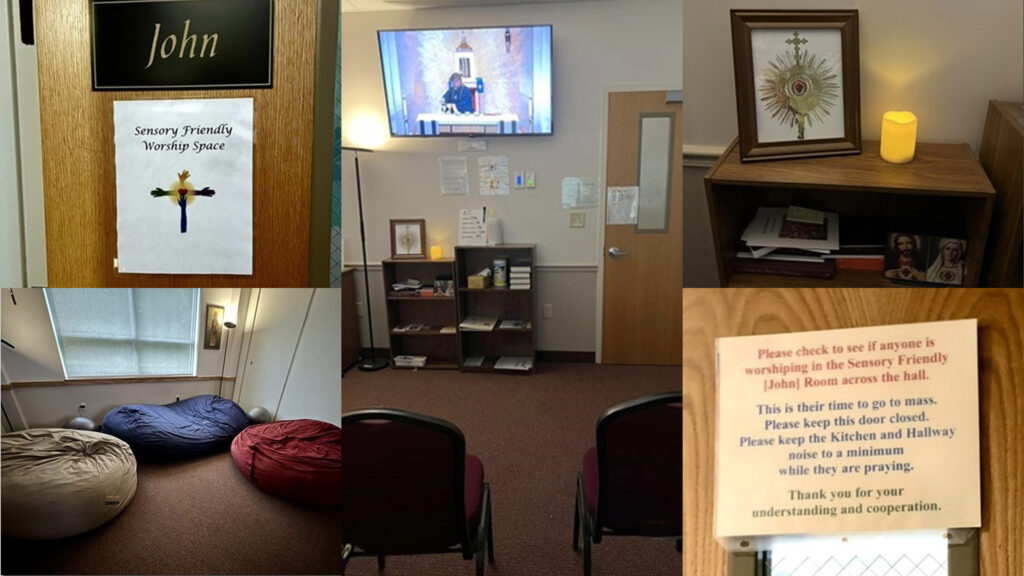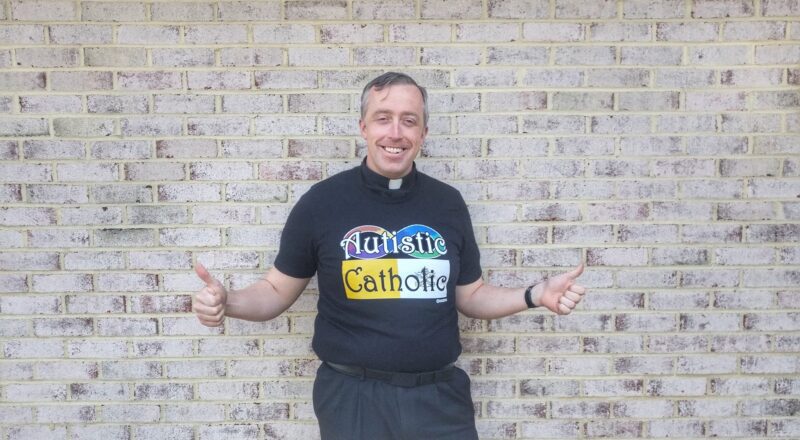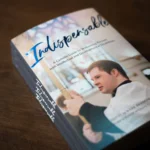I recently spoke to Aimee O’Connell of Autism Consecrated about her parish’s sensory-friendly room for Mass. This is St. Pus X in Rochester, New York: it’s on my sensory-friendly Mass directory. This will be the first in a series of three articles on parishes that have had sensory-friendly Masses or rooms during Mass for several years (second and third articles). I will cover a little background and then post her answers via email.
Background
St. Pius X is a relatively new church building after a fire. The sensory-friendly room was consecrated on December 23, 2018 and most of the background is from a March 2019 article in the diocesan paper:
In December, St. Pius Tenth Parish dedicated a new worship space that was created for parishioners of all ages who have sensory differences…
“I found a lot of families were saying we can’t attend (Mass) because it is too loud or bright,” said Johan Engstrom, St. Pius’ director of faith formation. “Families could not attend entire Masses or had to worship outside the nave.”
Engstrom, who has a family member on the autism spectrum, said the types of problems that were being described to him are common for individuals with sensory differences or who are on the autism spectrum. Thus, the idea to create a room in which both children and adults with sensory differences could worship was formed…
The room offers softer lighting; a variety of seating, including a huge bean bag chair, exercise balls and rocking chairs; and a volume control button on the wall to adjust the sound of the liturgy as it is being streamed onto a television monitor in the room. Parishioner Kelly Places painted a tactile mural on one wall that features different textures.
You can read the whole initial article in the Catholic Courier.

Interview with Aimee O’Connell on the Sensory-Friendly Room
Aimee indicates that the room has not gone as well as expected. The answers have been edited for length and reordered for clarity: I ran the draft by Aimee, and she approved her words.
Fr. Matthew Schneider, LC: Can you give me an update on the sensory-friendly room?
Aimee O’Connell: This room is part of the Parish Center and is a short walk from the nave through a connecting space and then down a corridor leading to several meeting rooms, storage rooms, and a large kitchen. There is a sign on the door indicating that this is the Sensory Friendly Worship Space. The room is out of sight to anyone in the church, and those worshiping therein watch Mass on a wall-mounted monitor. The A/V ministers in the church use iPads to control what is seen on the monitors and generally switch between wide-angle of the nave and close-up of whoever is speaking or preaching over the course of the liturgy.
At first, the parish had a well-defined protocol for including the room in all liturgies. Ushers were asked to account for anyone worshiping there in terms of attendance count and directing extraordinary ministers of Communion to bring Holy Eucharist to those in the room. At first, the room was used by a number of families with young autistic children as well as autistic teens, among whom was my oldest daughter. My husband and I, also both autistic, did not yet use the room because our two younger autistic children were altar servers and needed our presence in the pews for their own sense of security and confidence. My husband also served occasionally as an extraordinary minister of Communion and was stationed wherever he was assigned.
My oldest daughter was most grateful for the sensory room because she finds large gatherings overwhelming, and her stimming includes vocal tics when this causes distress. She said that even with younger children in the room, it was significantly easier for her to worship there and engage fully with all parts of the liturgy. She has mild scoliosis and joint hypermobility, and regularly made use of the bean bag chair – often commenting how much better able she was to focus when her body was able to relax. In contrast, sitting in the pews bothered her back and neck. Although the room offered tactile fidget tools, she brought her own sketchbook to help her focus. The younger children did make use of the fidgets provided. She was at ease in the room and rarely experienced tics in there.
Me: That seems like a great start. What has happened since then with the sensory-friendly room?
Aimee: In 2020, the COVID-19 pandemic shut the churches in our diocese. When we reopened, the sensory room was off-limits for several weeks. Gradually, families were permitted to sign up to attend Mass ahead of time through an online reservation system. The sensory room was reopened by reservation only, but was greatly pared back. All extra objects were removed, including prayer books and hymnals along with tactile items and visual Mass aides. Extraordinary ministers were no longer used anywhere in the liturgy and so worshipers had to walk into the church to receive Eucharist from either priest or deacon in carefully monitored single-file lines. As altar service by youth was suspended from 2020 to November 2023, our entire family began making use of the sensory room.
Even as liturgical life returned to pre-pandemic practices in all other respects, the parish continued to distance itself from the sensory room throughout 2021, 2022 and forward. We asked when extraordinary ministers of the Eucharist and hospitality ministers would resume their former roles and were told they would not. We noticed that we were the only ones using the room, and so asked if there could be signs posted and notices in the bulletin reminding other autistic parishioners of the room’s availability – and were told that the parish did not want to risk having more people start using the room. On top of this, the lighting in the room still had not been converted to a dimmer switch as promised when the room was first designed, and the audio system was not responsive to the controls intended to modulate volume…
Along with this divestment of interest from parish staff was an increasing treatment of the room as any other ordinary meeting room. Bean bags were removed whenever youth ministry wanted to use them, but not always returned afterward. Classes were scheduled to meet there during liturgies and would be in progress when we arrived for Mass, creating confusion and leaving us with no place to go. Social functions involving the use of the kitchen also took place while Masses were in progress (e.g., pancake breakfasts), with the people involved making huge amounts of noise and traffic in the corridor, so much that it was disruptive to worship even with the door closed. To our astonishment, parish staff were indifferent to how any of this impacted on our use of the sensory room. We made pleas to both staff and those using the rooms: the heads of youth ministry and faith formation, ushers, deacons, CYO, the Boy Scouts, Knights of Columbus – in other words, everyone who used the parish center during Mass without realizing that we were worshiping in the room with the sign reading Sensory Friendly Worship Space – and either had no response or were told to accept that this is a shared space. When we raised our concerns directly to the pastor, our messages repeatedly went unanswered…
After much prayer and frustration, we decided to honor the room’s dedicated mission with our own time and effort. At our own expense, we brought in three floor lamps with adjustable settings to use instead of the ceiling lights; we purchased and brought in ear defenders; we brought in memory foam kneeler pads; and we purchased a theater-grade acoustic-dampening curtain with tension rod, which was mounted in the corridor with a sign which reads “QUIET PLEASE – MASS IN PROGRESS.” The curtain is put up when the room is in use and taken down when we leave, to gently alert people in the corridor to our presence and foster reverence for the Mass, yet not denying access to rooms needed for scheduled activities.
Me: What have been some of the biggest struggles maintaining a sensory-friendly room?
Aimee: There need be no struggle in maintaining such a space, providing the parish is committed to fostering belonging and hospitality, bearing in mind that hospitality for some neurotypes looks one way, and for other neurotypes looks another way. The principle of hospitality is providing what people need because they are guests of Christ, and not deciding ahead of time what we are willing or not willing to do based on efficiency or projected headcount. One person is enough to offer hospitality, and we don’t always know when that one person will be there – so, hospitality dictates that we are watchful and ready to welcome the Bridegroom whenever He might show up.
Me: What is the attitude of parish leadership and parishioners? Does having a sensory-friendly room help promote neurodiversity at your parish?
Aimee: Parishioners will learn by the example of the parish leadership and staff. Right now, at St. Pius X, the “sensory people” are out of sight, and therefore, largely out of mind. We get strange looks from people when we come in for Eucharist, and we get people in the corridor coming up to the door and gawking at us during Mass like we are in a fishbowl. It is very awkward for all of us using the room (we range in age from 14 to 65). The Knights have to be reminded repeatedly that we are worshiping in there when they are making food during Masses in the kitchen across from us. Once or twice someone has stopped in and started socializing during Mass, as if we were simply “crashing” there and not actually worshiping. There is no conceptual understanding of what that room is or why we use it, and that falls back to the lack of any further action, communication, involvement or interest in supporting neurodivergent parishioners. We have asked for this repeatedly – asking various groups, persons, staff members, our pastor – and the answer has consistently been that there are not enough of us with this “affliction” (the actual term used in one reply) for these questions to be relevant to the entire parish. In other words, they do not see the need to do anything to raise awareness of neurodiversity or foster a culture of neurodiversity at our parish, despite having this room, despite having publicly dedicated it as a worship space, despite everything the Catholic Courier article says.
Me: This seems largely negative. Are there some positives that have happened?
Aimee: We engage with the liturgy remarkably better with lower lighting and smaller space. The sensory room is carpeted and absorbs sound much better than the church, where the marble floors and tall ceilings magnify both volume and reverberations. Since the beanbags have been returned, we appreciate the flexibility in seating, as this is a sensory support which optimizes our bodily sense of safety and openness to engagement.
As a neurodivergent family, we adhere to a growth mindset for ourselves, and we extend that outlook to others in our circle. St. Pius X parish is not where we could yet be in terms of neuroinclusion and belonging, but we choose to see this as a work in progress. Thus, we will continue using this space as it was intended, and we offer our presence, witness and perseverance for the conversion of the entire community, persisting in hope that the mission of this room.
Me: What elements do you have for a sensory-friendly room beyond the light and sound (sensory toys, cards showing the stages of Mass, etc.)? What might help other parishes?
Aimee: I think the best way to know what a sensory support room needs is to find out from parishioners directly, as it will be variable based on who will be using it and whether there are sensory-seeking or sensory-offset needs. I was not part of our parish’s planning for our sensory room, but my hunch is that it was initially designed for sensory-seekers and eventually evolved into sensory-offsets based on who is using the room. It begs the question, what if there are both (as there usually will be?) The answer will be up to the parish’s creativity. There is no reason to think there can’t be space both for sensory-seekers and sensory-reduction, and the kinds of supports in either setting would best be identified by the people who will be using them. It would be a helpful step away from the mindset that churches need to “provide for” autistic folks rather than involve autistic folks in the process as equal partners.
Me: What have you learned from running a sensory-friendly room for several years?
Aimee: What I have learned is that being authentically autistic is mission work. A parish might give a rhetorical welcome to all people of all abilities, but when requests for support are shot down because the unwritten parish policy is that we don’t do “favors” for one or two people (“because then we’ll have to do that for everyone!”) — the welcome falls very flat indeed. The sensory room is just one aspect of the pushback we have encountered at this parish when asking for accommodations to help us participate and engage in parish activities, ministries and sacramental preparation. We still have much ground to cover in making our community accepting of and accessible to neurodivergent parishioners.
Me: Is there anything that might help others trying to get such a room started at their parish?
Aimee: Start with understanding what it means to promote a culture of neurodiversity. Find sources from actually neurodivergent people and be willing to learn from actually neurodivergent people what we need, what we want, what prevents us from engaging. Approach this with humility and curiosity. Set aside concerns about scarcity. Engage us as equal partners. Rather than plopping down something “for” us, instead, seek what you can do “with” us. Seek what we can do “with” you. Remember that neurodivergent people have constantly fluctuating capacities and that accommodations for us may be frequently adjusted, as that is what our disability requires. Trust that we will not ask for more than we need or more than what is fair.
Conclusion
Aimee shows us the struggles that can happen in a sensory-friendly space even after a parish has committed to it. She is an example of persevering to include people, even when things are difficult. Keeping a sensory-friendly room at a parish active for over 5 years is impressive. This is an example to show people to keep going even if not everything seems right. The other two in this series will show more visibly positive results but Aimee shows the dedication to Jesus alone.
Note: I wanted to cover parishes that have had sensory-friendly Masses or spaces for a while. Usually, diocesan papers only cover them when they are new. I was commissioned to write a chapter on autism-accessible Masses in a collaborative book on disability theology with Word on Fire coming out later this year. For this chapter, I wanted to have such testimonies, which led me to interviewing three people. A few lines will be in the chapter, but the longer text will be here on my blog.










[…] my series of three parishes where a sensory-friendly Mass or space has been going on for a while. (First and third in the […]
[…] space for an extended period, we get to possibly the longest-running sensory-friendly room. (First and second in this series.) St. Peter Channel in Roswell, GA (north Atlanta suburb) has been […]
that is so sad I’m hoping church leaders recognize the significance of having a sensory room! As a catholic and mother of an autistic child I wish more churches embraced this
[…] published 3 longer interviews of people who have run these for a long time. They were located in in Rochester, NY, Fort Wayne, IN, and near Atlanta. Part of doing these interviews was making this chapter, so I had […]